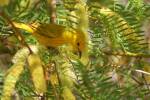Class will help when it comes to pruning plants, trees
It might be the dead of winter, but now it's the time to do pruning work to prepare your fruit trees, roses and ornamentals for the upcoming season. Pruning is critical and therefore causes concerns for those who don't want to do anything that might hurt the plants.
Though critical, you can carry out the pruning processes with great success by gaining some basic knowledge and skills. Help is closer than you think.
The Springs Preserve is hosting Dr. Green Thumb's Pruning with the Experts, featuring many local pros. They are Dennis Swartzell, one of Southern Nevada's pre-eminent arborists, who will go over the how, what, where and when of pruning. Russ Thompson will cover the essentials of training young trees. It's these early pruning decisions that set your trees up for long-term success, health and development. The clinic then breaks into sessions on fruit trees with Bob Morris; roses with rosarians; shrubs with Norm Schilling; and other specialty topics with experts on ornamental grasses, grapes, bonsai, tools, plant health and nutrition.
There will be lots of information and access to the experts the entire day. Pruning with the Experts is from 8:30 a.m. until 2 p.m. Saturday at the Springs Preserve, located at 333 S. Valley View Blvd. For more information, go to www.springspreserve.org.
With the right information and a little technique gained through Pruning with the Experts, you will be able to work on your own plants with confidence.
Pruning is like taking your plants to a hairstylist who thins, clips and balances your hair. Pruners clean out deadwood, thin out branches and bring trees into balance. Here are ideas to make pruning easier.
First, choose plants that mature within the designated space to avoid constant pruning. I see 20-foot-wide Pfitzers planted in 4-by-4-foot areas. Imagine what it's going to take to keep them in bounds. Once you start shearing junipers, you're committed to two to three times a year for as long as the plant lives.
Each plant has certain characteristics you need to know about. For example, ash and apple trees grow upward in V-shapes, so you'll remove the inside growth to spread them out. Mesquites and acacias spread out, so you'll remove those drooping branches to force the trees up.
Never leave a stub. It dies and it'll stare at you until you remove it.
When making final cuts, locate the branch collar or swelling, which is about a quarter-inch wide, wrapped around the branch where it attaches to the tree. Prune so that the collar remains on the tree. That collar has all the hormones necessary to quickly heal wounds.
Next, get rid of any dead, diseased wood. If the wood is flexible, it's alive, and if it snaps or is greenish-white under the bark, it's OK.
Then, thin out the trees. You want light and air inside to reduce leaf drop, improve leaf color, generate flowers and fruit, and reduce pest infestations.
Get rid of suckers at the plant's base and water sprouts on the limbs. They sap lots of energy, so rub them off.
If you have two limbs running parallel competing for light, get rid of one.
Use your watch as a guide to determine what limbs to take off the tree. You want limbs coming off the trunk at the 10 and 2 o'clock angles to allow the connecting wood to properly form around the branch attachment. Eliminate all narrower angled branches. The connecting wood cannot develop and may break off.
Never top trees. Wounds open trees to diseases and eventually kills them. Topped trees also produce lots of shoots, which means more pruning next year and ruins the natural beauty of the trees.
Finally, when you purchase plants, you signed a contract to prune them from the get go. Waiting a few years to prune will require major pruning later.
NATIVE PLANT SALE
As the Springs Preserve goes into its new format, native plants will be available. Here are the January offerings:
■ Winterfat puts on its show through the winter with eye-catching downy white fuzz.
■ Alkali sacaton has delicate pink flowers in the fall and becomes golden into winter.
■ Four wing salt brush is known for its unusual four-winged seeds that become food and shelter for wildlife.
■ Tufted evening primrose covers itself with very dramatic 4-inch-wide white blooms in the spring and fall.
■ Pyracantha koidzumii covers itself with white flowers in the spring and red-orange fruit in the fall that the birds enjoy.
■ Dalea bicolor has blue and white flowers blooming continuously from midfall into early spring.
Linn Mills writes a garden column each Sunday. You can reach him at linn.mills@ springspreserve.org or call him at 822-7754.























